Yoga 5 by 5: Potential Benefits and Basic Poses
We're all stories. These personal sagas assembled over time. There’s the childhood that seems endless. Followed by an adulthood that feels ridiculously rushed, yet glorious just the same. Each narrative eventually teaches us that only the precise present is what we have and know for certain. The rest is memory and speculation, a revered past and a desired future, with a dissonance rarely weighed. But throughout everything, sleek and topsy-turvy scenes alike, there are two constants: the mind and the body. Priceless as can be and ours to handle as we wish. Enter yoga, a resource that can bare great value when used to align both constants, strike balance, and regain control we either lack or misplaced.
Like slowly spreading butter across a warm piece of toast, yoga can augment our sense of time, seeming to elongate the present, giving us more room, distancing if not eliminating perceived barriers. This can render the human experience into something to savor rather than just survive. Few activities tend to be so transformative. In fact, more than many activities, yoga is also portable. That’s part of its charm and universal use. It can be practiced virtually anywhere and at any time. The mind and body are the only supplies you need to do it. If you have those two things available, then you are ready to begin. In a gym, at your desk, away from your desk, on a train, down a grocery store aisle. Name the spot and yoga can be there for you. Being a star athlete or having an affinity for exercise are not necessary. What matters most in the span of time you do it is the goodness that results, be it three minutes of posing or twenty. Yoga is at the peaceful, unbusy intersection of movement and stillness. If and how you arrive there is up to you. Here are five potential benefits that yoga may bring and five basic yoga poses.
Disclaimer: According to the National Center for Complementary and Integrative Health, people may want to speak with a doctor before trying yoga, especially if they:1
- have a pre-existing knee, hip, or spine injury
- have high blood pressure
- have balance issues
- are 65 years or older
- are pregnant
Additionally, yoga dates back thousands of years beginning in India and growing in interest and popularity throughout the world from there. While important to be aware of and deserving of great respect, the yoga's extensive roots and how it came to be what it is today will not be toured here. There are also different styles of yoga, with additional variations. However, what’s presented in this article is based on the author’s experience with the practice and yoga’s core concepts.
The Benefits
These are listed in no particular order and with equal importance.
1. Meditation – The idea of meditation seems to be based around a singular image: a person humming as they sit in solemn silence cross-legged with their index fingers pressed against their thumbs, as each of their hands lightly rests on a kneecap. This is meditation for some people, to be sure. But it’s not the only form of it. In fact, meditation, at least within the context of yoga, means a host of different things to different people. Incorporating mediation into your yoga can strengthen and elevate your practice. Being in and holding a yoga shape, whether it’s physically strenuous or not, reserves a space and time to gather your thoughts up as one would with a basket of clean laundry, and then meticulously sort through them, organizing them accordingly. Meditation is where you can work out something while not necessarily breaking a sweat in the process, though you still might in yoga.
Here is an opportunity to silence your surroundings as much as possible and welcome a measure of serenity. A meditation session may be based around one image, focusing on a wide-open space, a random point on a wall, nothing at all, or exclusively focused on your breathing and heart rate.
Even if you’re not stressed, practicing yoga supports centeredness through meditative actions, keeping your thoughts more linear as you begin to strengthen the relationship between mind and body.
2. Turn Down Stress/Crank Up Productivity – Each day introduces its bountiful share of conversations and events that may provoke a range of emotions from anxiety to sadness. We either respond in kind to such things or we find a way to move through and past them.
Yoga can be a much-needed balm before, during and after a busy day, reframing these quandaries so that they’re less problematic and more manageable. Meditation and slow, mindful breathing can encourage a decrease in feelings of tension or pressure. Many problems might appear immutable and engulfing, but what yoga does is make them seem more surmountable and distant at least for a time, allowing us the ability to re-calibrate and find a way to handle them.
Outwardly, yoga may appear like a passive activity, something to be done simply and quickly. But it requires some consideration if it’s going to become an impactful part of a person’s schedule and life. Not to mention, yoga encourages clarity, which itself can generate consistency and dedication. But the broader possibilities may reach even further.
Appointments tend to structure our days. A to-do list wields the power to decide how each day will unfold, with whom and in what order. But yoga can serve as both the plan and the planner.
Within yoga’s comforting quiet, sits an opportunity to order the myriad of things swirling around your head, very much out of order. By calming your mind, you indirectly allow it to help open pathways toward what comes next and maybe even engineer fresh ideas that hadn’t surfaced until that exact moment of calm. It is there, in whatever pose you find yourself, that yoga enlivens so that once your practice is completed for the day, you’re next to unstoppable for the remainder of it.
3. Flexibility – Remember Gumby? He was a small, green clay animation character created in the 1950s that enjoyed extreme popularity thereafter. Gumby was famously happy and often accompanied by his sidekick, a pony named Pokey. Gumby also had one chuckle-inducing characteristic: he was very stretchable. Enough so to put many a zany 1980s aerobics instructor to shame. When we think of stretching and enviable mobility today, that’s the pop culture image that springs to mind. Well, at least it is for this author.
The reality though is that we’re not made of clay and probably not destined to be so pliable. We have bones and muscles that require acute attention every day. They can do miraculous things, our bodies. Decades of repeated use and the Olympics prove that. But everybody is different, and we should be careful to treat ourselves as such. Yoga can help introduce or encourage more flexibility whether you’re simply trying to touch your toes or reach an itch on your back because a beloved backscratcher is missing. If allowed some time and training, you can become more flexible as you practice various poses and get your body comfortably acquainted with the shapes you want to make.
There is another concept to entertain here: flexibility of the mind. Being human is not for the faint of heart and practicing yoga gently supports our improvement at the mental gymnastics living seems to take.
4. Inflammation/Blood Pressure – So much of the scientific and health benefits of yoga comes from what it supplies us with internally. Inflammation is an invisible but often deeply felt problem for countless people, with the capacity to make one’s day unpleasant or downright painful. Fortunately, yoga has been shown to help in reducing inflammation. A study published in Oxidative Medicine and Cellular Longevity found that 12 weeks of yoga seemed to slow cellular aging. The program consisted of 90 minutes of yoga that included physical postures, breathing, and meditation five days a week over a 12-week period.2 Some of this success has to do with the deep meditation yoga entails as well as its breathing techniques. But yoga’s capacity to bolster our internal qualities doesn’t stop there.
Research has revealed that yoga may also aid in lowering our blood pressure levels. It’s no secret that high blood pressure is problematic for many as the U.S. Food and Drug Administration stated more than 119 million American adults have high blood pressure, while about 1 in 4 of those people do not have their condition under control.3 A 2019 review and analysis of earlier data published in Mayo Clinic Proceedings found that people who did yoga for an hour about five times a week for 13 weeks had significant reductions in their blood pressure.4 While such health benefits may be achievable, they also help demonstrate what consistent yoga practice can yield.
5. The Friend Maker – Yoga is often practiced in a solitary fashion. The work, intensity and dedication comes from the individual. Intrinsically, yoga can create a stronger sense of self. A person that extends, meditates and lightens mental or physical burdens can effectively enhance their perspective and their reactions to what happens to and around them. This conceivably boosts self-esteem and consequently, prompts a greater connection to other people. That’s right, yoga can not only jumpstart relationships, but it can keep them healthy as well, as it fosters a convivial mood.
Plus, yoga makes for an endlessly fascinating topic of conversation. Whether you practice yoga at a park or a studio, you can connect with others in a substantive way, which may further enrich your sense of belonging. Yoga means "to join one point to another" and that can also include building community.5
The Poses
Using a yoga mat is recommended but is not required. A solid and stable surface is ideal. These poses are presented for informational purposes only.
1. Simple Seat – A classic and one we’ve been doing in some form since kindergarten, Simple Seat involves sitting cross-legged and facing directly forward, with a straight spine. Gently rest the backs of your hands on your knees, all while breathing steadily. As you strive toward a deep calm in this shape, you may prefer to close your eyes to sink even further into it.
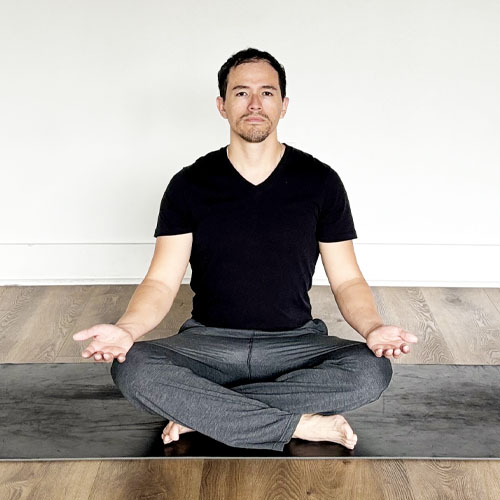
2. Mountain Pose – Stand with your feet firmly together, with your arms and palms angled slightly outward. Your fingers should be splayed fully open, and your palms should be facing forward, with your gaze forward or slightly downward. An alternative to this pose is spreading your feet about shoulder-width apart, for additional balance.
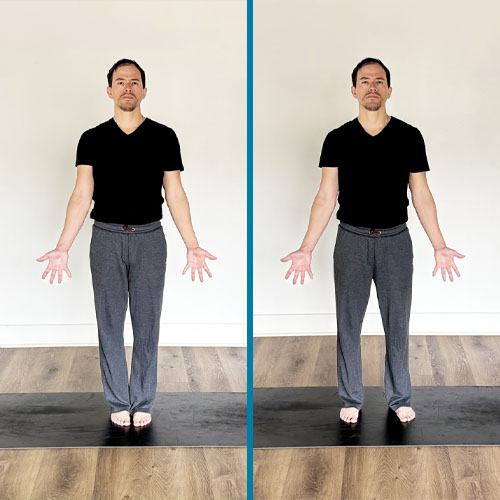
3. Tree Pose – This pose requires some additional balance and most especially some patience with yourself. Stand using just your right leg and then position the bottom of your left, foot against your ankle, calf, or inner thigh. Avoid placing your foot directly on your knee. Once balanced, your hands may be placed together at heart’s center. Be sure to alternate and use your left leg as your base. With this pose, you're engaging your quadricep and abdominal muscles, among other areas.
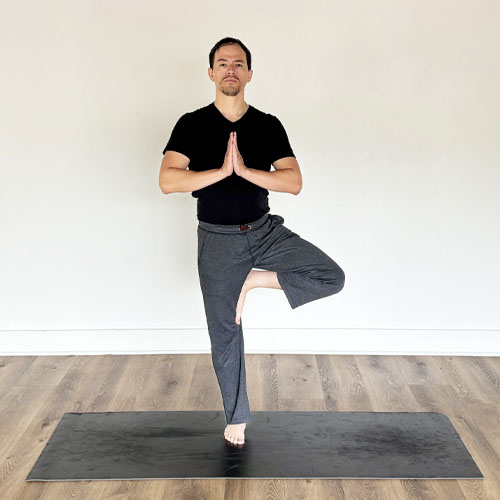
4. Warrior I – Place your left foot forward and your right foot all the way back at a diagonal from your left foot. Both your feet and heels should be flush against the ground. Your left foot and left leg should approach a 90-degree knee angle, while your right leg should be completely straight. Face forward with your shoulder and hips nice and squared. Next, raise your arms and hands directly above your head. You can hover your hands above you, mirroring one another, with your fingers aimed upward. But you may also prefer to steeple your fingers or clasp your hands together. Remember to switch legs for this shape. Indeed, the leg muscles are being activated a lot here.
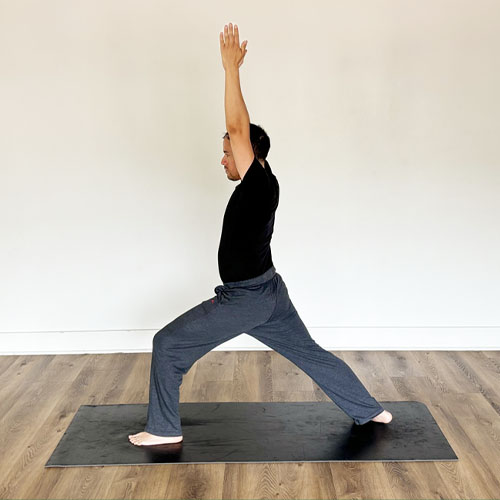
5. Warrior II – Switching up the positions of our legs, place your right foot forward, with your lower-right leg perpendicular to the floor, so your knee is directly above your ankle. Place your left foot all the way back as you did with your right foot in the previous shape. Again, both feet must be firmly against the ground. Raise both arms and straighten them. Turn your head and direct your gaze past your right hand’s fingertips. Your head should not be leaning forward or backward but centered over your body. There should be a near straight line from one set of fingertips to the other.
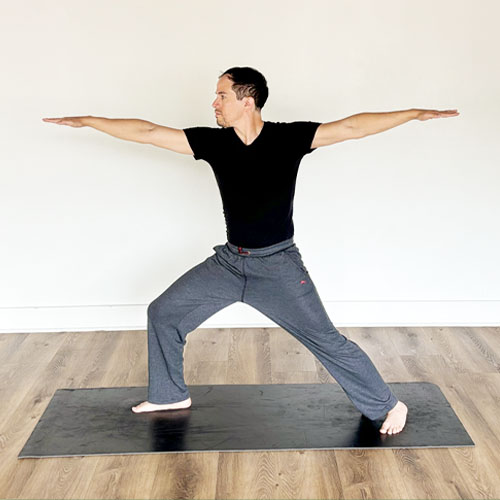
Bonus Poses to Complete the Sequence!
Chair Pose – Do you remember doing pantomime exercises as a kid? This shape is similar to that. Here, we’re pretending to sit on a chair that’s not there, working multiple muscles in the process. It’s also sort of like doing a squat at the gym except there’s no bar over your back and your knees can shift farther forward.
It’s time to sit on air! Begin by putting your feet about hip-width apart, then proceed to sit back as much as your body will allow, moving your posterior toward the floor. Sometimes called the lightning bolt, this pose can be interesting and difficult because the idea is to also raise your arms and hands, making them straight and aimed diagonally toward the sky. This author can attest it’s no easy feat. This is an especially dynamic pose that can stimulate the circulatory and metabolic systems.6 It may take some stretching along with repeated efforts to sink lower and really challenge gravity.
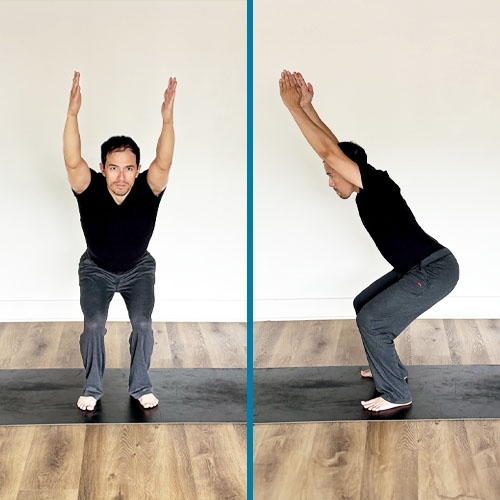
Child’s Pose – A potentially more relaxing and meditative shape, the child’s pose brings the body more closely together, encouraging a little stretching and possibly a micro nap. Here you’ll be just short of curling into a fetal position.
Start by sitting with your legs and knees tightly together and your shins resting against the floor. Drape the top half of your body over your legs, moving your forehead toward the ground. Then outstretch your arms and hands directly forward, firmly placing your palms and fingers onto the ground. Finally, gently rest your forehead on the ground.
If this shape is uncomfortable, consider separating your knees as needed and/or draping your hands alongside your hips toward your feet. Allow your arms to be passively straight, while the backs of your hands rest against the ground, with your palms facing the sky.
Additionally, adding a smile to any of these poses may be helpful. (There's no need to be as stoic as the man in the photos.)
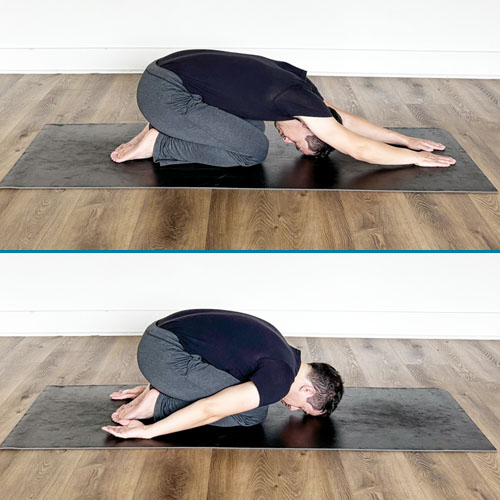
Adaptations
You can try any of these adaptations using an ottoman or a stable four-legged chair.
Mountain Pose – Take a seat in a chair. Keep your back fully straight, with your chin up and your gaze forward. Place your hands to the side at a slight angle, palms open, fingers splayed wide.
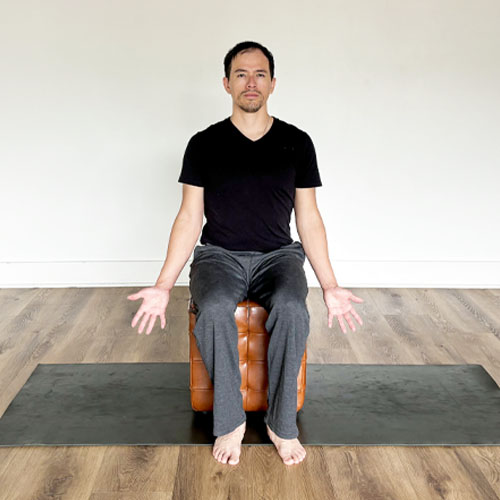
Tree Pose – Sit back on the chair. Place your right foot on the floor, aligning your right hip, knee, and ankle. Next, press the sole of your left foot against the side of your right inner thigh. With your back straight and your shoulders squared, you can place your hands at heart's center. Don't forget to alternate sides.
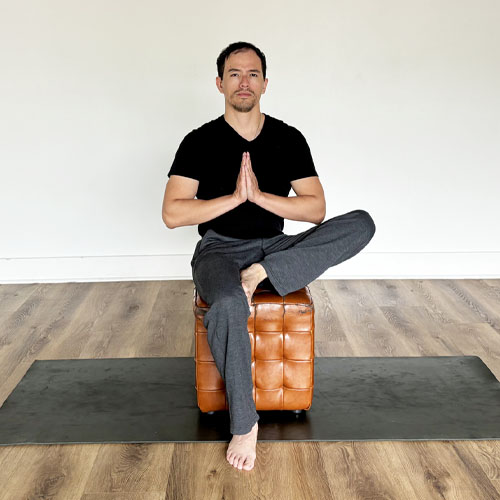
Warrior I – Position yourself atop the center of the chair. Place your left foot forward, forming an approximate 90-degree knee angle over the side of the chair. Your right leg and foot should be stretched back with the bottom of your foot against the ground and your right leg as straight as you can get it. Your hands should be directly above your hand, reaching toward the sky. Next, switch sides.

Warrior II – Again position yourself atop the center of the chair. Place your right leg forward, making a near 90-degree angle over the chair’s rim. Then make sure your left leg and foot are diagonal from your right side, with your left foot pressed against the floor. Then open your arms front to back, creating a straight line from fingertips to fingertips. Gaze over your front hand. Then, switch sides.
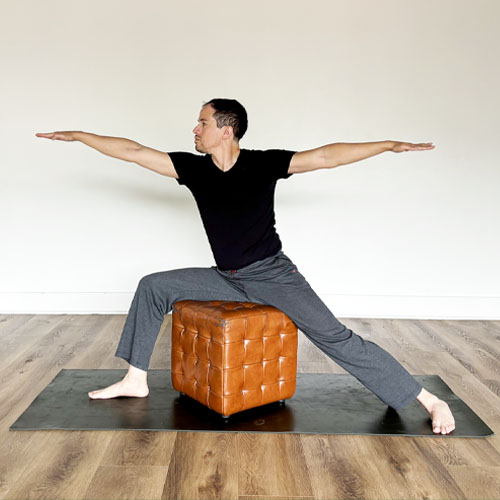
Chair Pose – Lastly, there is the modified Chair Pose. Here you’ll also want to be all the way back on the seat you’re using. Have your legs and feet at a shoulder-width distance. Raise your hands directly over your head, leaving some space between them.
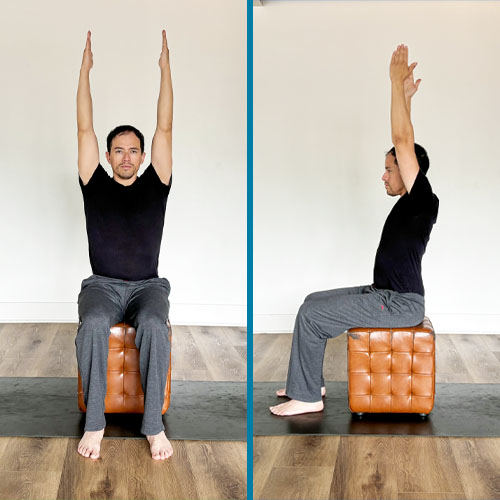
That concludes the five potential benefits of yoga and some of its basic poses. But let's consider a few more ideas before wrapping up.
If we were to take a widescreen, unedited panorama of our days, we’d probably find them compelling, a colorful and peculiar experiment to watch with a bag of fresh popcorn. Crowded with a multitude of feelings, days are filled with manifold tasks demanding care and labor. But we have dependable patterns in place that can limit the chances of swerving from an established trek. These patterns also induce comfort and a quiet confirmation there is more order in our lives than is readily apparent; we need such stability for the long haul. As practicing adults, each day usually begins in a simple and similar style: preferably with a shining sun to greet us, we rise from slumber, trailed by an audible yawn to enliven the scene, then we brush our precious teeth, floss even, before once again continuing a wieldy, memorable life.
Things don’t stay simple though. What unfolds after this common routine is where people diverge. In these successive hours one’s mental and physical health are strengthened and nourished in parts, while being challenged or brought into question. At times, the bad can all but neutralize the good. Without a panacea to spring us along, one has to consider ways to continue with one’s wits nicely intact. Rewarding, available activities like yoga invites calm in the face of distress, potentially easing a bit of discomfort and granting a well-deserved break in the clouds.